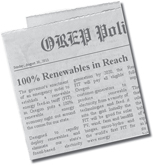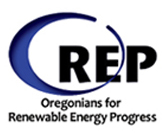What's New
May 2010
- Friday, April 30, 2010
Oregon Public Utility Commission (PUC) Staff submitted new recommendations on Volumetric Incentive Rates (VIRs) for Oregon’s Feed-In Tariff, to the PUC Commissioners (posted at http://apps.puc.state.or.us/edockets/docket.asp?DocketID=15820). The new VIRs were based on new installed cost data submitted by stakeholders in comments that closed April 19, 2010.
Staff have outlined three VIR rate options (Tables 1,2 and 3), all using 25th percentile installed cost data from Energy Trust of Oregon and assuming loan financing at 7.5%:
- Table 1 VIR rates from their Feb 17th Comments used ETO data from 2008-2nd qtr 2009
- Table 2 VIR rates based on 4th qtr 2009 + 1st qtr 2010 installed cost data
- Table 3 VIR rates based on 2008, 2009 + 1st qtr 2010 installed cost data
All the tables show rates for two project sizes (<10kw and 10-100kw) in four “insolation zones” (reflecting varying amounts of sun in Oregon) for a total of 8 different tariff rates:
- Table 1 VIR rates are:
<10 kw 10kw-100kw
Zone 1: .75 .55
Zone 2: .70 .55
Zone 3: .65 .55
Zone 4: .60 .55
- Table 2 VIR rates are
<10 kw 10kw-100kw
Zone 1: .65 .55
Zone 2: .60 .55
Zone 3: .60 .55
Zone 4: .55 .55
- Table 3 VIR rates are
<10 kw 10kw-100kw
Zone 1: .70 .55
Zone 2: .65 .55
Zone 3: .60 .55
Zone 4: .55 .55
Zones 1-4 include these counties:
Zone 1: Benton, Clackamas, Clatsop, Columbia, Lane, Lincoln, Linn, Marion, Multnomah, Polk, Tillamook, Washington, Yamhill
Zone 2: Coos, Douglas, Hood River
Zone 3: Gilliam, Jackson, Josephine, Klamath, Morrow, Sherman, Umatilla, Wallowa , Wasco
Zone 4: Baker, Crook, Deschutes, Jefferson, Lake, Malheur, Harney
- Monday, May 3, 2010
OREP submitted its first grant application to the Bullitt Foundation to help support our efforts to build a movement Implementing Oregon’s Feed-In Tariff for Smaller-Scale Solar Electricity. Our object is to employ Oregon’s Feed-In Tariff (FIT) to bring widespread, small-scale solar PV production and its benefits into Oregon’s population centers.
- Tuesday, May 4, 2010
One of OREP’s coalition partners, Columbia Riverkeeper, won a HUGE VICTORY on May 4th , when Houston-based Northern Star declared bankruptcy, effectively ending its bid to build a Liquefied Natural Gas (LNG) terminal at Bradwood Landing on the Columbia River, one of three such projects proposed for Oregon. This marks an incredible victory for the 5-yeqr grassroots coalition led by Columbia Riverkeeper, Citizens Against the Pipeline, Oregon Wild, BARK, Sierra Club and others who organized a broad spectrum of environmental advocates, farmers, fishermen and property owners to oppose building LNG terminals, laying pipelines and bringing in LNG tankers just to create dependence on another imported fossil fuel and damage Oregon’s valuable rivers, forest and farmland in the process. Read all the details at http://www.columbiariverkeeper.org .
- Tuesday, May 4, 2010
OREP joined Sierra Club and over 100 citizens attending the DEQ Title V Air Quality Permit hearing for Portland General Electric. OREP testified in support of Sierra Club’s comments that PGE’s Boardman coal plant should be closed by 2014, removing the largest stationery source of CO2 emissions in the state, rather than burdening ratepayers will millions of dollars of emission control devices that will be useless when the plant closes in 2020 anyway. OREP testified that this money should be directed toward energy efficiency and solarizing Oregon’s built environment with rooftop solar PV.
- Friday, May 14, 2010
Solidarity Rally for the Gulf Coast: OREP will stand in solidarity with the people of the Gulf Coast who are looking at massive job losses and devastated coastlines. Rally sponsors are the Sierra Club, Climate Solutions and Environment Oregon. We need to protect our communities and our coastal economies and switch to a clean energy future. This oil disaster shows that offshore drilling is risky, dirty, and dangerous. It's time to move forward with an aggressive plan to end our addiction to oil and build a clean energy economy. Signs will be provided and afterwards we will go over to the Eastburn and grab a beer. If you have a fun costume or t-shirt wear it! For info contact Robin Everett at robin.everett@sierraclub.org or call 503-238-0442 x 307 www.coalfreeoregon.org
WHEN & WHERE: Friday, May 14th 5:00-6:00 PM Circle K Gas Station at 2020 E. Burnside
- Saturday, May 15, 2010
OREP will participate in and table at the next in the series of forums on energy issues sponsored by Community for Earth of First Unitarian Church and Alliance for Democracy’s Portland Chapter.
TOPIC: Liquefied Natural Gas in Oregon - Where do we go from here? On the heels of the tremendous May 4th victory of Oregon’s anti-LNG coalition, speakers will discuss what comes next. One of the three LNG terminals will now hot be built, but that is not the end of the story. Two other proposed terminals, in Astoria and Coos Bay, have not yet been stopped. Come for a report on the current status and future actions to continue opposition to LNG in Oregon.
SPEAKERS: Olivia Schmidt, Columbia Riverkeeper, Oregon Sierra Club and Monica Vaughan, “Hey NW Natural”
WHEN & WHERE: 10:00 AM in the Buchan Building at the First Unitarian Church, SW 12th and Salmon in Portland.
- Week of May 17th
POSSIBLE PUC DECISION: Now that rulemaking has concluded and PUC Staff have submitted tariff rate (VIR) recommendations, the PUC Commissioners “could” issue decisions on Administrative Rule 538 (how the pilot program will operate) and UM 1452 (covering tariff rates). The Commission’s decisions will direct the utilities to file compliance tariffs. After that, probably sometime in June, there will be a public meeting to review the tariffs proposed by the utilities. By law, Oregon’s FIT pilot must begin July 1, 2010.
- Monday, May 17, 2010
OREP members are keeping track of revisions to Oregon’s Solar Code that could affect the amount of roof-space available for solar PV. The next Solar Code subcommittee meeting will be held in Salem at the Building Codes Division on Edgewater, Monday, May 17, 2010 at 1:30 pm - 4 pm. To learn more or attend, contact Kim Berhorst at kimb@nationalsolarusa.com 503-999-6269
- Tuesday, May 25, 2010
OREP has a place on the agenda at the next meeting of Sierra Club’s Beyond Coal Task Force. How shall we replace the 600MW of power the Boardman coal plant now produces? How can Feed-In Tariffs help? If you are or know a Sierra Club member, please encourage them to attend.
WHEN & WHERE: 7:00 PM at Sierra Club’s Portland office, 1821 SE Ankeny Street.
- Thursday, May 27, 2010
Join OREP at the “Sierra Club and allies” third annual rally outside NW Natural Gas shareholder meeting. Fresh on the heels of the bankruptcy of Northern Star Natural Gas and the abandonment of the Bradwood Landing LNG proposal (see above), we need to send a strong message to NW Natural to abandon their plans to build the Palomar gas pipeline. Tell NW Natural Gas shareholders that Palomar is a bad investment that will damage the Mt. Hood National Forest, impact hundreds of streams and rivers, damage farmland, and raise the gas bills of their customers. With Bradwood Landing LNG suspended and their parent company now bankrupt and owing millions to investors, NW Natural should not stay on board this sinking ship. It is time to pull the plug on the Palomar Pipeline!
OREP will participate in the RALLY TO STOP THE PALOMAR PIPELINE!
We will point out that LNG is the WRONG DIRECTION and that more renewables through FITs is the RIGHT DIRECTION.
If you can help hold OREP’s banner and signs, please contact Judy Barnes at 503-232-1911.
WHAT, WHEN & WHERE: NW Natural Gas Shareholders meeting
Thursday, May 27th 1pm-4pm, Oregon Convention Center, 777 NE MLK Blvd, Portland
For info see: http://action.sierraclub.org/site/R?i=vn5IvOqcnoHUXeKtauGnlw
- Thursday, May 20th
VALUABLE NEW TRAINING TOOL: On May 20, 2010 RenewableEnergyWorld.com hosted a webinar entitled "The Future of German Feed-in Tariffs and its Impact on the German and Global PV Market". The broadcast originated in Germany and covered the history of Germany's FIT, how it works, and explaining its most recent success - that Germany has now achieved price parity with fossil fuels for ground mounted solar and expects the same for rooftop solar by 2013! This is a valuable educational tool for those who want to understand the power of Feed-In Tariff policies. You can download the webinar from click here
- Friday, May 28th
Oregon's PUC issued its much-anticipated orders for AR538 (the administrative rules) and UM 1452 (the tariff rates) describing what Oregon's "Feed-In Tariff" pilot program of solar incentives will look like and how it will operate.
You can read both decisions at:
AR 538 (45 pages): click here
UM 1452 (23 pages): click here
Briefly:
1 - The Commission chose the cautious approach to addressing the issue of FERC jurisdiction, going with Staff's recommendations for a Net-metering plus VIR program design for projects <100KW and Competitive Bidding for projects >100kW - 500kW, instead of a traditional Feed-In Tariff design. The Commission lays out the arguments in favor and opposed to this option quite fully in pages 3-11 of the UM1452 order.
2 - Rates will begin at $ .65/kWh for projects <10kW in Portland and go down from there for each of the other three solar zones. Projects >10kW - 100kW will all receive $ .55/kWh.
3 - The 25MW capacity of the whole program will be divided up among projects so that 50% will consist of projects <=10kW, 30% of projects >10kW - 100kW and 20% of projects >100kW -500kW.
4- Oregon's pilot program cannot be called a true Feed-In Tariff, because systems <100kW will not receive the incentive rate for any production that exceeds their usage and projects >100kw-500kw will not receive fixed rates but will participate via competitive bidding. However, Oregon's program is: 1) the first to reserve capacity for small scale projects and will offer the highest incentive rate in the country for small projects, and 2) the first not to fund any part of the program from state tax credits, which means renewables will no longer be competing for the same tax dollars that fund education and public safety.
See how the PUC describes the program at click here
- Saturday, May 29th
The Oregonian printed a front page article on the PUC decision by Business Reporter Rich Read in their May 28-29 edition. The article is notable for its accuracy and fairness. The online version of "Solar program to pay Oregonians premium rates for power they generate" is at click here. Feel free to add to the online comments. The May 29th print version was headlined: "Ready for PGE to Pay You?"
********************************************************
Stay tuned! OREP will post new developments in this space.
Click here for older archived updates:
_______________________
OREP's New Vision for a sustainable energy future:
- Solar panels on neighborhood homes, small businesses, churches, and schools
- Average Oregonians producing solar energy and earning a return ontheir investment
- Local lenders financing solar projects in rural and urban Oregon, tokeep money circulating locally
- A stable and flourishing solar industry with living wage jobs
- Widespread support among voters for a solar subsidy plan they participate in and benefit from directly


